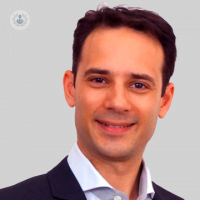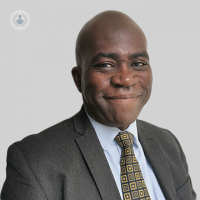What is pinnaplasty?
Ear correction surgery, where the ears are pinned back, is known as pinnaplasty or otoplasty. The cosmetic surgery procedure is used to change the size or shape of the ears, or to pin them back if they stick out. It is usually carried out on children and teenagers but some adults may opt to have the procedure too. Children under the age of five are unable to have pinnaplasty as their ears are still developing and growing.
What happens during a pinnaplasty?
Pinnaplasty is performed under local or general anaesthetic, depending on the age of the patient. The operation usually takes about one to two hours. The surgeon will make a cut to the back of the ear and peel off some skin from the cartilage. The shape of the cartilage is changed so that the ear is closer to the head. The doctor can also correct the symmetry of the ears too. The wounds are then closed with stitches and a dressing is applied.
There is a newer technique known as incisionless otoplasty to treat prominent ears, which involves scoring the cartilage through the ear skin using a needle. No incision is made. There is not a lot of evidence about the long-term quality of this procedure.
What happens after pinnaplasty?
Following surgery, the ears may be sore, tender or numb for a few days and the patient may need to wear a bandage around their head. They will not be able to wash their hair for a few days whilst leaving the dressing on to protect the ears from infection. It is useful to sleep upright for a few nights following surgery.
There may be bruising for a few weeks and it is recommended taking the time off school or work to let these heal. The stitches may come to the surface and cause the ear to feel sore, which can be treated with over the counter pain medications. After 10 days the stitches are removed.
What are the possible complications of pinnaplasty?
Complications are unusual. There can be a collection of blood between the skin and the cartilage, which creates 'cauliflower ear'. On some occasions, the skin may scab and the patient must be very careful with their dressings to ensure that underlying cartilage is not exposed, dried out or infected. If it does dry out then it can cause a misshapen ear and another procedure will be needed to repair the hole with a skin graft. If the area is red, swollen or painful post-operation, this may be a sign of infection and the patient should consult their doctor.
10-05-2023Pinnaplasty
What is pinnaplasty?
Ear correction surgery, where the ears are pinned back, is known as pinnaplasty or otoplasty. The cosmetic surgery procedure is used to change the size or shape of the ears, or to pin them back if they stick out. It is usually carried out on children and teenagers but some adults may opt to have the procedure too. Children under the age of five are unable to have pinnaplasty as their ears are still developing and growing.
What happens during a pinnaplasty?
Pinnaplasty is performed under local or general anaesthetic, depending on the age of the patient. The operation usually takes about one to two hours. The surgeon will make a cut to the back of the ear and peel off some skin from the cartilage. The shape of the cartilage is changed so that the ear is closer to the head. The doctor can also correct the symmetry of the ears too. The wounds are then closed with stitches and a dressing is applied.
There is a newer technique known as incisionless otoplasty to treat prominent ears, which involves scoring the cartilage through the ear skin using a needle. No incision is made. There is not a lot of evidence about the long-term quality of this procedure.
What happens after pinnaplasty?
Following surgery, the ears may be sore, tender or numb for a few days and the patient may need to wear a bandage around their head. They will not be able to wash their hair for a few days whilst leaving the dressing on to protect the ears from infection. It is useful to sleep upright for a few nights following surgery.
There may be bruising for a few weeks and it is recommended taking the time off school or work to let these heal. The stitches may come to the surface and cause the ear to feel sore, which can be treated with over the counter pain medications. After 10 days the stitches are removed.
What are the possible complications of pinnaplasty?
Complications are unusual. There can be a collection of blood between the skin and the cartilage, which creates 'cauliflower ear'. On some occasions, the skin may scab and the patient must be very careful with their dressings to ensure that underlying cartilage is not exposed, dried out or infected. If it does dry out then it can cause a misshapen ear and another procedure will be needed to repair the hole with a skin graft. If the area is red, swollen or painful post-operation, this may be a sign of infection and the patient should consult their doctor.


FAQs about ear pinning surgery
Professor Paul Chatrath
2024-12-30
Is it a major operation? Is there an ideal age for surgery? How can I refer my child for ear pinning surgery? And how much does it cost? We put your most common questions about ear pinning surgery to Mr Paul Chatrath , a distinguished London ear, nose and throat surgeon, specialising in rhinology and facial plastic surgery. Mostrare di più


Getting your ears pinned back – how does it work?
Mr Raj Lakhani
2024-12-30
The ears, as with any facial feature, come in all shapes and sizes and for some they can appear as very prominent or protruding. Some people will choose to have surgery to create natural-looking ears. This procedure is called an otoplasty, which Mr Raj Lakhani, a top ENT surgeon, is an expert in. Here he explains what an otoplasty is, how it is performed and the risks involved. Mostrare di più


Life after a pinnaplasty
Mr Mike O`Connell
2024-12-28
A pinnaplasty (also known as otoplasty) is a straightforward operation to reset the outer ear or "pinna" to a more favourable position, closer to the side of the head, to make the ear appear less noticeable. Doctor Mike O’Connell tells us more about the pinnaplasty procedure and what to expect after it. Mostrare di più


Otoplasty: a step-by-step guide to the procedure
Mr Anil Joshi
2024-12-26
Surgery to get your ears pinned back has evolved in recent years, and it’s now possible to reshape the ears without cutting the cartilage entirely. In this article, consultant ENT and facial plastic surgeon Mr Anil Joshi explains how modern surgeons approach ear surgery and what kind of recovery patients can expect. Mostrare di più
Medici esperti in Pinnaplasty
-
Professor Paul Chatrath
OtorinolaringoiatriaEsperto in:
- Settoplastica
- Amigdaliti
- Pinnaplasty
- Rinite
- Sinusite
- septorhinoplasty
-
Mr Abbad Toma
OtorinolaringoiatriaEsperto in:
- Chirurgia endoscopica naso sinusale
- Rinologia
- Rinoplastica
- Pinnaplasty
- Rinite
- Settoplastica
-
Mr Timothy Mellor
Chirurgia plastica, estetica e riparatriceEsperto in:
- Blefaroplastica
- Ascensore fronte
- Cancro alla pelle sul viso
- Lifting facciale
- Chirurgia plastica facciale
- Pinnaplasty
-
Professor Kayvan Shokrollahi
Chirurgia plastica, estetica e riparatriceEsperto in:
- Laser
- Lesioni cutanee
- Nei
- Pinnaplasty
- Carcinoma delle cellule basali
- Cancro della pelle
-
Mr Kwamena Amonoo-Kuofi
OtorinolaringoiatriaEsperto in:
- Apnea ostruttiva del sonno
- Amigdaliti
- Sinusite
- vertigini
- Mucoide dell'ortitorio
- Pinnaplasty
- Visualizzare tutti

New Victoria Hospital
New Victoria Hospital
184 Coombe Lane West, Kingston upon Thames, KT2 7EG
No existe teléfono en el centro.
Se utilizzi questo numero di Top Doctors autorizzi al trattamento dei dati a fini statistici e commerciali. Per maggiori informazioni, leggi la nostra l’informativa sulla privacy
Top Doctors

The Park Hospital - part of Circle Health Group
The Park Hospital - part of Circle Health Group
Sherwood Lodge Drive, Burntstump Country Park, Arnold, Nottinghamshire NG5 8RX
No existe teléfono en el centro.
Se utilizzi questo numero di Top Doctors autorizzi al trattamento dei dati a fini statistici e commerciali. Per maggiori informazioni, leggi la nostra l’informativa sulla privacy
Top Doctors

The Outpatients and Diagnostic Centre at 30 Devonshire Street (HCA)
The Outpatients and Diagnostic Centre at 30 Devonshire Street (HCA)
30 Devonshire St, London W1G 6PU
No existe teléfono en el centro.
Se utilizzi questo numero di Top Doctors autorizzi al trattamento dei dati a fini statistici e commerciali. Per maggiori informazioni, leggi la nostra l’informativa sulla privacy
Top Doctors
-
New Victoria Hospital
184 Coombe Lane West, Kingston upon Thames, KT2 7EG, South LondonEsperto in:
- Cardiologia
- Chirurgia generale
- Chirurgia ortopedica
- Chirurgia plastica
- Gestione del dolore
- Colonna vertebrale
-
The Park Hospital - part of Circle Health Group
Sherwood Lodge Drive, Burntstump Country Park, Arnold, Nottinghamshire NG5 8RX, ArnoldEsperto in:
- Chirurgia generale
- Chirurgia maxillo facciale
- Chirurgia orale
- Chirurgia plastica, estetica e riparatrice
- Ginecologia e Ostetricia
- Podologia
-
The Outpatients and Diagnostic Centre at 30 Devonshire Street (HCA)
30 Devonshire St, London W1G 6PU, Central LondonEsperto in:
- Chirurgia ortopedica
- Chirurgia spinale ortopedica
- Dolore muscoloscheletrico
- Ecografia muscolo-scheletrica
- Stenosi del canale
- Iniezioni spinali
- Visualizzare tutti
- Trattamenti più letti
- Roncopatia e apnea
- Polisonnografia
- Nistagmo (movimento oculare incontrollato)
- Chirurgia di femminilizzazione facciale
- Emicrania
- Chirurgia ad accesso minimo (chirurgia del buco della serratura)
- Il cancro della testa e del collo
- Collo
- Matrice dermica acellulare
- Ricostruzione del seno prepettorale







